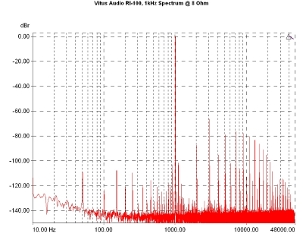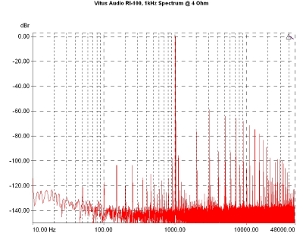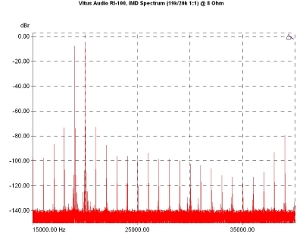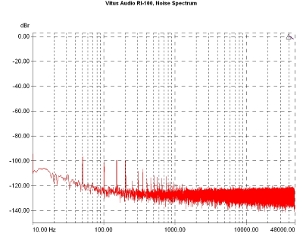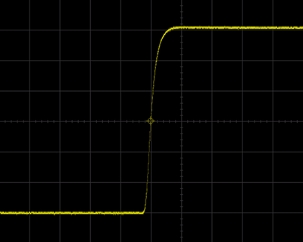about Audio, High Fidelity
& Home Entertainment technologies
pid: 607-2025/10/01 (v1.2)
Privacy Policy

RI-100 output power measurements fully confirmed the manufacturer's claims. Setting a rather conservative level of distortion (0.3% THD+N) the amp yielded over 290Wrms in 8-Ohm loads. Surprisingly, this value remained constant when 4-Ohm loads were used, a rather strange behavior for an amplifier with this kind of output stage and power supply. However, this paradox was due to the different way in which the distortion increased under different load conditions. This is best shown in the relevant diagram (THD+N Vs Power Vs Load, which you can find further down in this page) where the two curves coincide exactly in this distortion value. The amplifier behaved as expected closer to its power limit (THD+N at 1%). This time, the values we got were 300Wrms/8-Ohm and 430Wrms/4-Ohm. With a power increase factor of 1.4 and the ability to offer such power levels, ΡΙ-100 appears to be more than capable to drive any demanding loudspeaker. Damping factor was estimated close to 17, a rather low value corresponding to an output resistance slightly below 0.5 Ohm, which -however- does not suggest problems in the frequency response when a real-world loudspeaker is driven.
Static (i.e. single frequency) distortion measurements ranged in typically low levels close to 0.030% for both harmonic distortion and total harmonic distortion and noise (0.0301% and 0.0320%, respectively, referenced to 1/3 of the maximum power in 8-Ohm loads). A similar behavior was observed in terms of intermodulation distortion (0.0295% SMPTE, 1/3 Pmax at 8-Ohm loads). With 4-Ohm loads, the level of performance decreased somewhat with the corresponding values at 0.1248% and 0.1359% (THD/THD+N) and 0.0849% (IMD/SMPTE). The amplifier proved typically quiet with a signal to noise ratio -78.8dBr(A) with a reference level corresponding to the 1/3 of the maximum power.
Output spectrum with a 1kHz signal at 1/3 of maximum power includes a clearly visible set of harmonics, strongest of which are the odd ones. Of these, the third harmonic is close to -65dBr for 8-Ohm loads and to -60dBr for 4-Ohm loads. In both cases, one can observe a clear involvement of the power supply noise from the (50/100Hz and their intermodulation products).
Spectrum analysis with 1kHz signal input. Reference level: 1/3 of maximum power in 8-Ohm load.
Spectrum analysis with 1kHz signal input. Reference level: 1/3 of maximum power in 4-Ohm load.
Intermodulation spectra (with 19/20kHz signals in 1:1 level ratio) include the expected components with those under 4-Ohm loading being in a slightly higher level.
IMD spectrum analysis. Two-tone, 19/20kHz, 1:1 level ratio signal. Reference level: 1/3 of maximum power in 8-Ohm load.
IMD spectrum analysis. Two-tone, 19/20kHz, 1:1 level ratio signal. Reference level: 1/3 of maximum power in 4-Ohm load.
Noise spectrum (in reference to 1Wrms/8-Ohm and with shorted inputs) reveals a rather noiseless amp, with clearly visible components due to the power supply (but in quite low levels, below -100dBr). Despite the use of an extended digital control circuit and a display, high-frequency noise was very low without any visible interference components.
Frequency response with purely resistive loads appeared to be wide with a very mild cutoff below 50Hz (-1dBr at 10Hz) and with a minimum deviation from 0dBr up to 60kHz. Channel differences were, probably, the lowest we have ever measured in an amplifier (being in the order of thousandths of a dBr). Quite interesting is the fact that this very good behavior was also observed during the volume control tracking test. Differences between channel levels (channel balance) were below 0.1dB for settings down to -36dB with values up to 0.006dB and 0.026dB for the -9dB and -18dB settings respectively. With a complex load, the frequency response acquired some visible deviation which, however, did not exceed 0.2dB. This is, obviously, connected with the rather low damping factor we observed earlier and for any practical purpose, should be assessed as a minor, insignificant fact.
Noise spectrum. Reference level: 1Wrms in 8-Ohm load, input shorted.
Frequency response for both channels. Reference level: 1/3 of maximum power in 8-Ohm load, (green/red curve), and in complex (simulated loudspeaker) load (orange/magenta).
Variation of the total harmonic distortion and noise (THD+N) as a function of frequency did not offer any surprises given the static measurements already mentioned. Measured values range was between 0.03% and 0.04% for 8-Ohm loads and around 0.1% for 4-Ohm loads, for the 1/3 of the maximum output power.
THD+N relative to the power output graph suggests an output stage with a rather gradual behavior. With an 8-Ohm load, distortion increases faster (especially over the 250Wrms point), but it remains at low levels over a wider range of output power in comparison with the 4-Ohm load measurement. The graph in the latter case is much smoother (which is why the two curves intersect at 0.3%) but below 250Wrms, the amplifier exhibits higher distortion rates.
THD+N as a function of frequency at 1/3 of maximum power in 8-Ohm load (green curve) and 4-Ohm load (red).
THD+N as a function of the output power. 1kHz input signal in 8-Ohm (green curve) and 4-Ohm (red) load.
Finally, the square-wave signal response appeared to be smooth and without any obvious transient phenomena. Rise time estimated at 4uS and the slew rate at 32.4V/uS.
1kHz squarewave response. Maximum output voltage in 8-Ohm load. Horizontal axis: 5uS/Div, vertical axis: 10V/Div.

